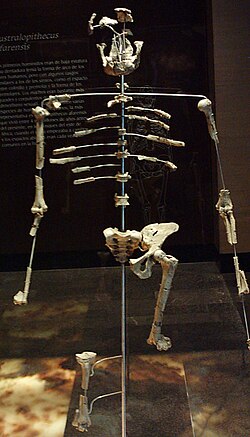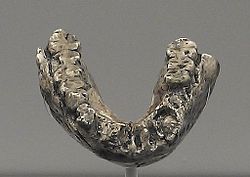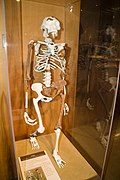Australopithecus afarensis
Australopithecus afarensis is an extinct hominid. It lived between 3.9 and 2.9 million years ago. A. afarensis was similar to slightly later Australopithecus africanus. It had a slender build.
| Australopithecus afarensis ("Lucy") Temporal range: Pliocene
| |
|---|---|

| |
| Lucy replica, Museo Nacional de Antropología, Mexico City | |
| Scientific classification | |
| Kingdom: | |
| Phylum: | |
| Class: | |
| Order: | |
| Family: | |
| Subfamily: | |
| Genus: | |
| Binomial name | |
| †Australopithecus afarensis | |
A. afarensis may be more closely related to the genus Homo than A. africanus. Homo includes the modern human species, Homo sapiens.[1][2]
The most famous fossil is the partial skeleton named Lucy (3.2 million years old) found by Donald Johanson and colleagues, who, in celebration of their find, repeatedly played the Beatles song Lucy in the Sky with Diamonds.[1][2]
Australopithecus Afarensis Media
References
- ↑ 1.0 1.1 Johanson D.C. & Maitland A.E. 1981. Lucy: the beginning of humankind. St Albans: Granada, 283–297. ISBN 0-586-08437-1
- ↑ 2.0 2.1 Wood B.A. 1994. Evolution of australopithecines. In Jones S. Martin R. & Pilbeam D. (eds) 2004. The Cambridge encyclopedia of human evolution. 8th ed, Cambridge University Press, 234. ISBN 0-521-46786-1




